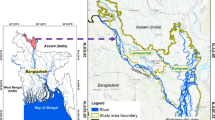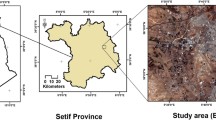Abstract
We developed a forest type classification technology for the Daxing′an Mountains of northeast China using multisource remote sensing data. A SPOT-5 image and two temporal images of RADARSAT-2 full-polarization SAR were used to identify forest types in the Pangu Forest Farm of the Daxing′an Mountains. Forest types were identified using random forest (RF) classification with the following data combination types: SPOT-5 alone, SPOT-5 and SAR images in August or November, and SPOT-5 and two temporal SAR images. We identified many forest types using a combination of multitemporal SAR and SPOT-5 images, including Betula platyphylla, Larix gmelinii, Pinus sylvestris and Picea koraiensis forests. The accuracy of classification exceeded 88% and improved by 12% when compared to the classification results obtained using SPOT data alone. RF classification using a combination of multisource remote sensing data improved classification accuracy compared to that achieved using single-source remote sensing data.




Similar content being viewed by others
References
Aghabalaei A, Maghsoudi Y, Ebadi H (2016) Forest classification using extracted PolSAR features from compact polarimetry data. Adv Space Res 57(9):1939–1950. https://doi.org/10.1016/j.asr.2016.02.007
Borghys D, Yvinec Y, Perneel C, Pizurica A, Philips W (2006) Supervised feature-based classification of multi-channel SAR images. Pattern Recognit Lett 27(4):252–258
Breiman L (2001) Random forests. Mach Learn 45(1):5–32
Bu CGTZY (2007) Ministry of Land and Resources, P.R.C
Cloude SR, Pottier E (1997) An entropy based classification scheme for land applications of polarimetric SAR. IEEE Trans Geosci Remote Sens 35(1):68–78
Evans DL, Farr TG, VanZyl JJ, Zebker HA (1988) SAR polarimetry: analysis tools and applications. IEEE Trans Geosci Remote Sens 26(6):774–789
Freeman A, Durden SL (1998) A three-component scattering model for polarimetric SAR data. IEEE Trans Geosci Remote Sens 36(3):963–973
Furtado LF, Silva TSF, Novo EMLM (2016) Dual-season and full-polarimetric C band SAR assessment for vegetation mapping in the Amazon varzea wetlands. Remote Sens Environ 174:212–222. https://doi.org/10.1016/j.rse.2015.12.013
Holm WA, Barnes RM (1988) On radar polarization mixed target state decomposition techniques. In: Radar, IEEE national conference—RADAR, pp 249–254
Huett C, Koppe W, Miao Y, Bareth G (2016) Best accuracy land use/land cover (LULC) classification to derive crop types using multitemporal, multisensor, and multi-polarization SAR satellite images. Remote Sens 8(8):684. https://doi.org/10.3390/rs8080684
Huynen JR (1978) Phenomenological theory of radar targets. Electromagnetic scattering. Academic Press, New York, pp 653–712
Kasapoglu NG, Anfinsen SN, Eltoft T (2012) Fusion of optical and multifrequency polsar data for forest classification. Paper presented at the 2012 IEEE international geoscience and remote sensing symposium. 22–27 July
Krogager E (2006) Properties of the sphere, diplane, helix (target scattering matrix) decomposition. Mol Ecol 15(11):3205–3217
Laurin GV, Frate FD, Pasolli L, Notarnicola C, Guerriero L, Valentini R (2013) Discrimination of vegetation types in alpine sites with ALOS PALSAR-, RADARSAT-2-, and lidar-derived information. Int J Remote Sens 34(19):6898–6913
Lee JS, Grunes MR, Ainsworth TL, Du LJ (1998) Unsupervised classification using polarimetric decomposition and the complex Wishart classifier. IEEE Int Geosci Remote Sens 4(5):2178–2180
Li X, Chen Y, Tong L, Luo SY (2016) A study on vegetation cover extraction using a Wishart H- classifier based on fully polarimetric Radarsat-2 data. Int J Remote Sens 37(12):2844–2859. https://doi.org/10.1080/01431161.2016.1192307
Ling F, Li ZY, Erxue C, Wang QK (2009) Comparison of ALOS PALSAR RVI and Landsat TM NDVI for forest area mapping. In: Asian-Pacific conference on synthetic aperture radar, pp 132–135
Ma N, Hu YF, Zhuang DF, Wang XS (2010) Determination on the optimum band combination of HJ-1AHyperspectral data in the case region of Dongguan based on optimum index factor and J-M distance. Remote Sens Technol Appl 25(3):358–365
Maghsoudi Y, Collins MJ, Leckie DG (2013) Radarsat-2 polarimetric SAR data for boreal forest classification using SVM and a wrapper feature selector. IEEE J Sel Top Appl Earth Obs Remote Sens 6(3):1531–1538. https://doi.org/10.1109/jstars.2013.2259219
Masjedi A, Zoej MJV, Maghsoudi Y (2016) Classification of polarimetric SAR images based on modeling contextual information and using texture features. IEEE Trans Geosci Remote Sens 54(2):932–943. https://doi.org/10.1109/tgrs.2015.2469691
Niculescu S, Lardeux C, Grigoras I, Hanganu J, David L (2016) Synergy between LiDAR, RADARSAT-2, and Spot-5 images for the detection and mapping of wetland vegetation in the Danube Delta. IEEE J Sel Top Appl Earth Obs Remote Sens 9(8):3651–3666. https://doi.org/10.1109/jstars.2016.2545242
Rahman MM, Sumantyo JTS (2010) Mapping tropical forest cover and deforestation using synthetic aperture radar (SAR) images. Appl Geomat 2(3):113–121
Richards JA, Jia XP (1986) Remote sensing digital image analysis: an introduction, 3rd edn. Springer, Berlin
Sun H (2006) The research of Spot5 application in forest inventory. Thesis for the Master Degree. Central South University of Forestry and Technology, pp 52–55
Touzi R, Landry R, Charbonneau FJ (2004) Forest type discrimination using calibrated C-band polarimetric SAR data. Can J Remote Sens 30(3):543–551
Uhlmann S, Kiranyaz S (2014) Integrating color features in polarimetric SAR image classification. IEEE Trans Geosci Remote Sens 52(4):2197–2216. https://doi.org/10.1109/tgrs.2013.2258675
Wang LH, Zhao ZY (2005) Automatically Classifying and Identifying the TM remote sensing images of forest mixed with conifer and broadleaves using improved BP ANN. Sci Silvae Sin 41(6):95–100
Yamaguchi Y, Yajima Y, Yamada H (2006) A four-component decomposition of POLSAR images based on the coherency matrix. IEEE Geosci Remote Sens Lett 3(3):292–296
Author information
Authors and Affiliations
Corresponding author
Additional information
Project funding: The work was supported by the National Natural Science Foundation of China (Nos. 31500518, 31500519, and 31470640).
The online version is available at http://www.springerlink.com
Corresponding editor: Tao Xu.
Rights and permissions
About this article
Cite this article
Yu, Y., Li, M. & Fu, Y. Forest type identification by random forest classification combined with SPOT and multitemporal SAR data. J. For. Res. 29, 1407–1414 (2018). https://doi.org/10.1007/s11676-017-0530-4
Received:
Accepted:
Published:
Issue Date:
DOI: https://doi.org/10.1007/s11676-017-0530-4




